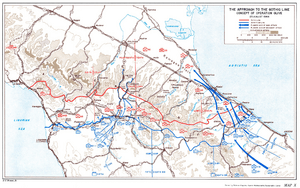Battle of Garfagnana facts for kids
Quick facts for kids Battle of Garfagnana |
|||||||||
|---|---|---|---|---|---|---|---|---|---|
| Part of the Italian Campaign of World War II | |||||||||
 The Gothic Line, in red. Garfagnana was in the most western section, next to Lucca and Massa |
|||||||||
|
|||||||||
| Belligerents | |||||||||
| Commanders and leaders | |||||||||
| Strength | |||||||||
| 18,000 men 120 tanks 140 artillery pieces |
9,100 men 100 artillery pieces |
||||||||
| Casualties and losses | |||||||||
| nearly 1,000 killed/missing in action 300+ prisoners taken |
about 1,000 killed/missing in action | ||||||||
The Battle of Garfagnana was a short but important fight during World War II. The Germans called it Operation Winter Storm, and Italians nicknamed it the "Christmas Offensive."
This battle happened in December 1944 in the mountains of northern Italy. It took place near the towns of Massa and Lucca. It was part of the Italian Campaign, where Axis forces (Germany and Italy) fought against the Allied forces (like the United States and Britain).
The Axis forces attacked the western part of the Gothic Line, which was a strong defensive line built by the Germans. They managed to push the Allies back for a short time. However, the Allies quickly took back the lost land.
Why Did the Battle of Garfagnana Happen?
After Benito Mussolini was put back in charge of parts of Italy, he and his Defense Minister, Marshal Rodolfo Graziani, wanted to build a new Italian army. They wanted this army to fight alongside Germany but still be independent.
Their big plan was to attack the Allies in Tuscany. They hoped to take back important cities like Lucca, Pisa, and Livorno. They thought they could use 40,000 soldiers and airplanes for this attack. However, the Italian army didn't have enough weapons, tanks, or planes for such a large operation.
Because of this, the Germans decided to launch their own, smaller attack. They used about 9,000 soldiers, mostly Italians, to attack a small part of the Gothic Line in Garfagnana. Their goal was to push the Allies back about 25 kilometers (15 miles).
In November 1944, parts of the U.S. 92nd Infantry Division moved into the Garfagnana area. They tried to capture the town of Castelnuovo di Garfagnana but were not successful.
How the Battle Unfolded
In mid-December, after the big Battle of the Bulge in Belgium, the Allies thought the Axis might try another attack in Northern Italy. So, they moved two brigades from the Indian 8th Infantry Division to help the U.S. 92nd Infantry Division near Lucca.
On December 26, 1944, the "Operation Winter Storm" began. Italian and German soldiers attacked the American 92nd Infantry Division. The Axis forces had about 9,100 troops, with most of them being Italians. They had 100 artillery pieces but no tanks. The Allied forces were much larger, with 18,000 troops, 140 artillery pieces, and 120 tanks.
The Axis forces aimed to capture several small towns north-west of Lucca. These towns included Barga, Sommocolonia, Vergemoli, and Fornaci di Barga. By December 27, the attack was mostly over. German troops entered Pian di Coreglia.
The next morning, the Axis troops had pushed more than 25 kilometers (15 miles) into the Allied lines. The town of Barga was captured by the Germans and Italians. Some U.S. soldiers planned to retreat all the way to Lucca.
However, the German and Italian forces soon stopped their attack and pulled back. Barga was recaptured by the Allies about a week later, by New Year's Day. The Gothic Line in this area stayed in place until late March 1945.
Images for kids



